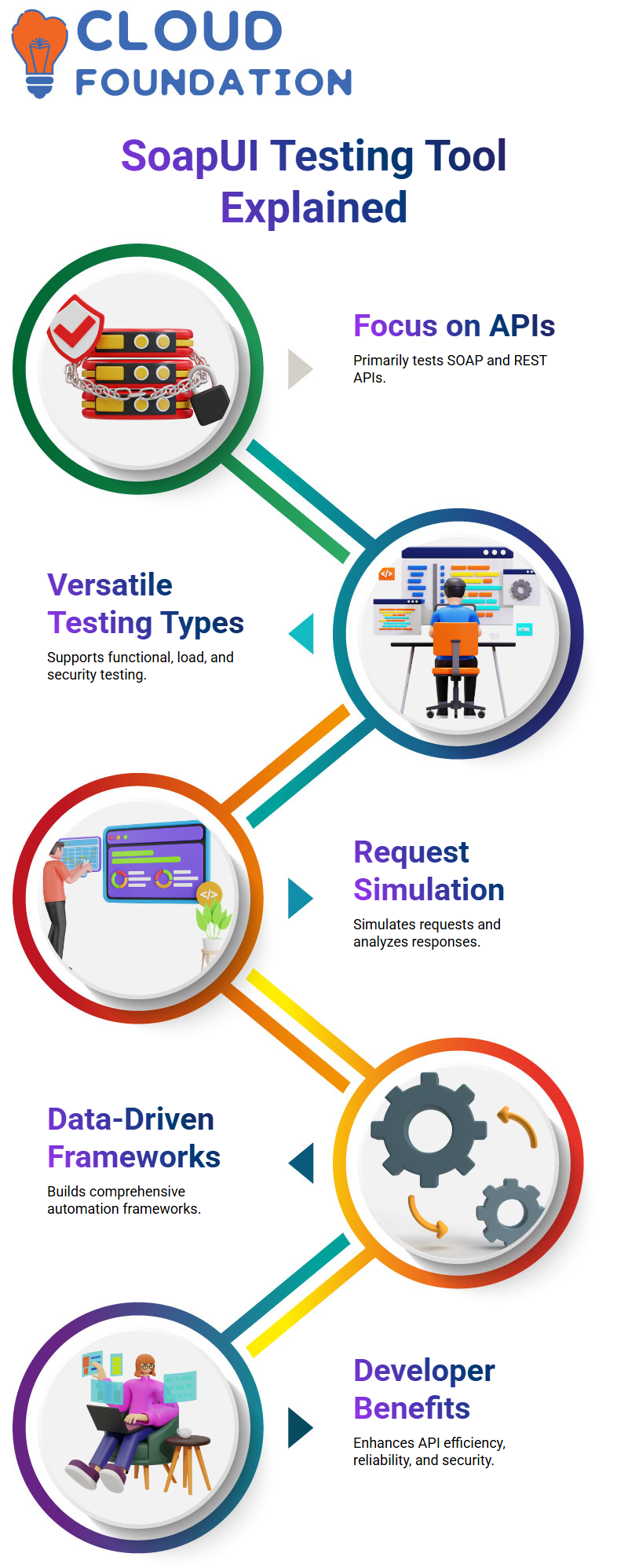SOAP UI Tutorial
What is Soap UI?
Simple Object Access Protocol User Interface (SOAP UI) is a robust and open-source tool used for testing web service applications. Its primary focus is on SOAP and REST application programming interfaces (APIs).
Additionally, we will investigate data-driven testing and develop a comprehensive automation framework using SoapUI simultaneously.
It allows users to perform functional testing, load testing, and even security testing of APIs.
With SoapUI, you can simulate requests and responses, analyse the results, and ensure that your web services are functioning as expected.
It’s beneficial for developers and testers who want to ensure their APIs are efficient, reliable, and secure.

REST APIs
SOAP UI effectively supports testing REST APIs, providing tools to create and manage test cases with ease, making it simple to test and validate REST API functionality during development.
REST (Representational State Transfer) APIs are a widely used architectural style for designing networked applications.
They allow applications to communicate over HTTP by defining a set of rules for interacting with resources. Here’s a simple breakdown of REST APIs:
REST APIs are used extensively for everything from retrieving weather information to enabling communication between mobile apps and backend servers.
Web Service in SOAP UI
A WSDL document can be created for the web service to process and fulfil all EPA requests on behalf of the user.
The web service is then created using the WSDL and API calls or requests. The API calls or requests are then made, and the WSDL is passed. The web service has generated all the API calls and requests, and a WSDL has been created for each operation.
Process of API documentation in a Web Service
The process involves creating a single test case with one request for each operation and then closing all of these operations. The document then shows that the test suite has a single test case, which contains all requests or API calls.
Creating API documentation is a straightforward process that can be accomplished using various tools and techniques.
By creating detailed documentation for each API, users can easily share their knowledge and understanding of the API’s functionality and capabilities.
This documentation can be used to provide others with accurate and accessible documentation, ensuring the API is adequately documented.

Groovy in SOAP UI
The Groovy script is a powerful tool for creating and editing text. It allows users to type in various formats, including log dot info and quotes. The script also allows users to change the font, size, and other settings within the editor settings.
A passive Groovy is a Java syntax-compatible object-oriented programming language that runs on the Java Virtual Machine (JVM) platform.
Groovy is both a static and dynamic platform, featuring similarities to those of Python, Ruby, Perl, and Smalltalk. It can be used as both a programming language and a scripting language, making it a versatile language.
The Groovy script is a versatile tool that allows users to create and edit text in various formats, including log dot info, quotes, and other formatting options.
By utilising the Groovy script, users can create and edit text without having to follow complex rules or follow strict formatting guidelines.
SOAP UI log dot.Info( )
In SoapUI, log. Info () is a Groovy scripting method used to log informational messages during test execution.
These messages appear in the SOAP UI console, helping to track the progress of your script, facilitate debugging, and monitor test results. For example, you can log the status of a test step or display responses received from an API
How does the End-to-end test case work in SOAP UI?
We will review the verification, validation, and validation aspects of the test case.
The first request we will add is to get all projects in a workspace. We will keep this request, and we will also use other resource requests that we don’t want to add in this particular test case.
When you open or expand this test case, you will see that you create, update, delete, and retrieve our project. Workspace requests are being added, and we will need a workspace GID to pass in this particular request. To obtain the details of all projects, we will need to retrieve the workspace ID, which will enable us to identify the specific requester.
We will provide multiple workspaces and workspace TIGs for each test. For each test, we will hard-code the value and then pass it to the test case.
Twitter application in SOAP UI
The Twitter application uses a Python code snippet; the user is prompted to input a tweet and then clicks the “Get Timeline” button.
The user then submits the request and receives a response. The user then wants to add an insertion to validate the response and confirm that the response received is correct.
The user then needs to add this request to a test case, which is a collection of tweets that have been sent out.
Then click on the “Add this REST request to a test case” button and select the “Add the request to a test case” icon. The test suite icon is called, and the Twitter demo for the test case name is called.
The user then adds the request to the “get timeline” method, which is a Twitter API for generating timelines.
The user then clicks the “Get Timeline” button and enters the URL of the timeline they want to use. The user then clicks on the “OK” button to submit the request.
The user then adds the request to the timeline, which is then submitted to the “get timeline” method. The user then checks if the response is correct and confirms that it is indeed accurate.
We need to add the request to the timeline, validate the response, and add the request to the timetable.
Conclusion
SoapUI is a powerful, open-source tool that provides an extensive suite of functionalities for testing web service applications, with a particular focus on SOAP and REST APIs.
It offers a comprehensive platform for developers and testers to conduct functional, load, and security testing, ensuring the reliability, efficiency, and security of their APIs.

With features such as Groovy scripting, query creation, and the ability to generate API documentation, SoapUI proves to be a vital tool for automating and testing workflows.
The tool’s ability to handle both SOAP and REST APIs makes it highly versatile for various web service testing needs. Through its detailed documentation capabilities and support for dynamic testing using Groovy scripts, users can efficiently monitor test progress and troubleshoot issues.
Additionally, its support for creating end-to-end test cases, such as in the example of Twitter’s API, showcases how SoapUI can streamline the testing process for both simple and complex API interactions.
Overall, SoapUI serves as a vital resource for ensuring that web services perform as expected under various conditions, providing users with the tools necessary to automate and manage their testing processes effectively.

Navya Chandrika
Author



